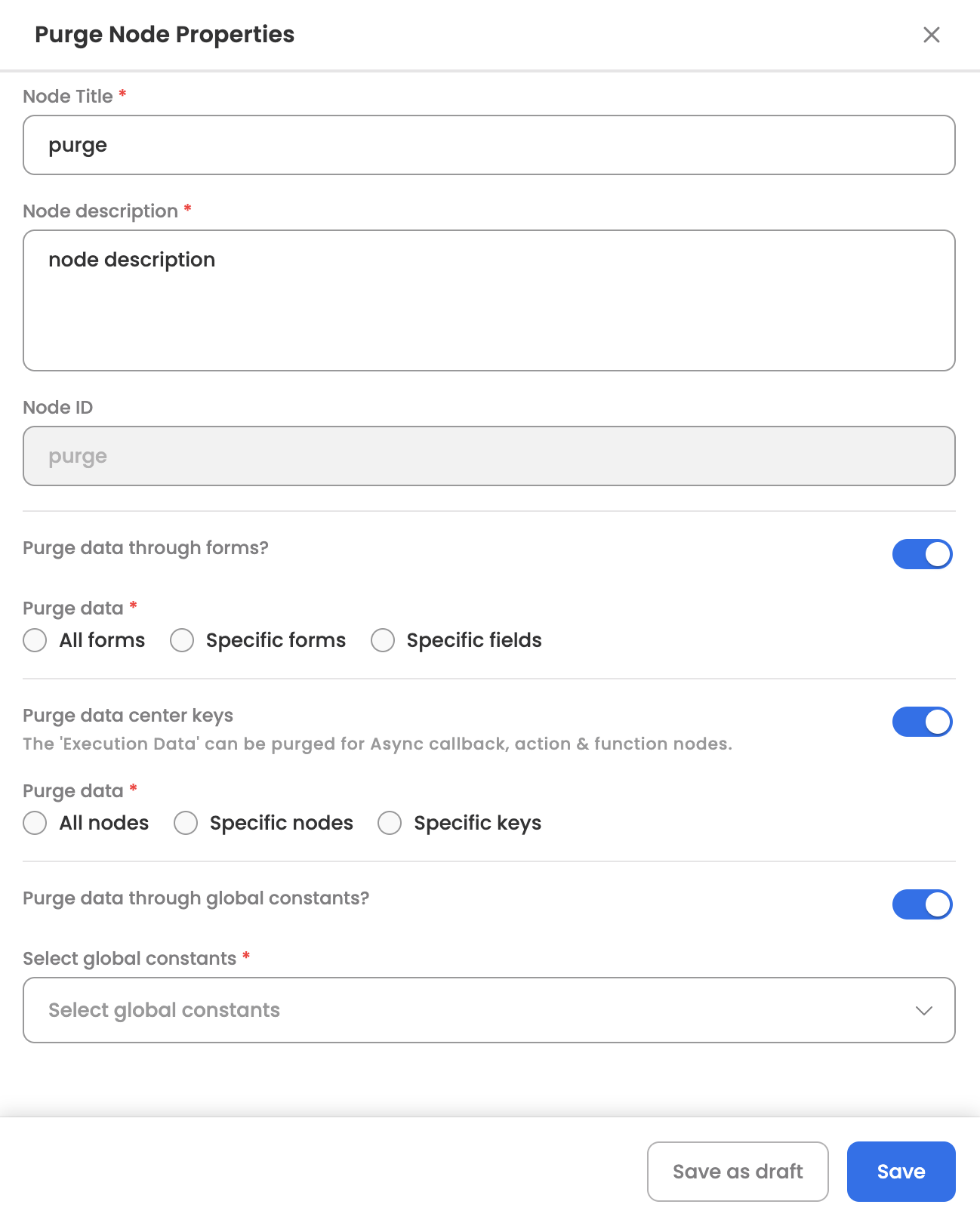Purge Node
Purge Node, a new and essential tool in Workflow Builder designed to give you precise control over the data lifecycle within your automated processes. This node allows you to delete data at any point in a workflow securely and selectively, helping you manage data privacy, comply with regulations, and optimize data storage.
Whether it's user-submitted form data or responses from integrated systems, the Purge Node ensures that information is only retained for as long as it's needed.
Key Features
- Flexible Placement: Add the Purge Node anywhere in your workflow by simply dragging and dropping it onto the canvas. It supports a single incoming and a single outgoing branch.
- Selective Form Data Purging:
- All Forms' Data: Delete data from all forms within the workflow instance.
- Specific Form’s Entire Data: Target a particular form and remove all its data.
- Form-Specific Field Data: Granularly select and purge data from specific fields within a chosen form.
- Targeted Data Center Purging:
- Remove response or execution data generated by Action Nodes or Function Nodes.
- The Data Center view within the Purge Node configuration will specifically list these eligible data keys.
- Choose to purge data by multi-selecting individual keys or by selecting an entire Action/Function Node's data block.
- User Notification for Purged Forms: End-users are clearly informed when they access forms from which data has been purged.
- Admin Visibility: Track the execution and configuration of the Purge Node through the workflow's progress path.
How to Add and Configure
- Adding the Node:
- Locate the Purge Node in the Workflow Builder palette.
- Drag and drop it onto your workflow canvas at the desired point in the process.
- Connect it using a single incoming and a single outgoing path.
- Node Configuration: Upon selecting the Purge Node, you can configure what data to delete:
- Purge Form Data:
- All Forms' Data: Select this option to remove data from every form associated with the workflow instance.
- Specific Form’s Entire Data: Choose a specific form from a list, and all its submitted data will be purged.
- Form Specific Field Data: First, select a specific form, then choose one or more fields from that form whose data you wish to purge.
- Purge Data Center Data:
- The configuration will display a view of the Data Center, filtered to show only response/execution data from Action Nodes and Function Nodes.
- You can then:
-
Select multiple individual data keys to purge.
-
Select an entire Action Node or Function Node to purge all its associated response/execution data.

-
- Purge Form Data:
Impact on User Interface & Admin View
- Progress Path (Admin View): For administrators monitoring workflow instances, the progress path for a Purge Node will display:
- Triggered At: Timestamp of when the node started execution.
- Completed At: Timestamp of when the node finished execution.
- Configuration: A summary of what was configured to be purged (e.g., "Data from Form: 'Expense Report'" or "Data Center Keys: 'API_Response.user_details'"), without displaying the actual purged values.
- My Items & Form Views (End-User Dashboards/Web-views): When an end-user accesses a form from which data has been purged by this node:
- A banner message will be displayed clearly at the top of the form: "The form details have been purged as per the business flow defined in the workflow."
- This message ensures transparency and informs the user about the data modification.
Why Use the Purge Node?
- Data Privacy & Compliance: Helps meet data protection regulations (e.g., GDPR, CCPA) by allowing timely deletion of personal or sensitive information.
- Data Minimization: Retain only necessary data within your workflows, reducing storage footprint.
- Process Cleanliness: Remove temporary or intermediate data that is no longer relevant to the subsequent steps of a workflow.
- Enhanced Control: Provides workflow designers with explicit tools to manage the data lifecycle within their automated processes.
Updated about 1 month ago
